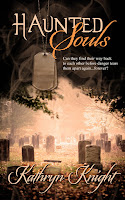I enjoy learning about the reasons behind traditions and beliefs...for example, I've done popular posts on
Why 13 is Considered Unlucky, The Origin of Halloween, and
Why People Fear Black Cats. As you may notice, these topics have a common element--the paranormal--one of my favorite subjects, as well as the inspiration for my novels. My first two novels,
SILVER LAKE and
GULL HARBOR, as well as my upcoming release HAUNTED SOULS, combine steamy romance with spooky hauntings.
My Young Adult novel,
DIVINE FALL, is a little different. When my children were younger, I taught Sunday School, and a passage from the Book of Genesis inspired a new supernatural idea. Divine Fall is the story of the only surviving Nephilim--the offspring of heavenly angels and human women who roamed the earth before the Great Flood. Divine Fall recently won the
Reader's Choice Award in Young Adult Romance at The Romance Reviews, which was an exciting achievement...and it's a reviewer nomination for the upcoming
BTS Red Carpet Book Awards, so I'm keeping my fingers crossed!
As a Sunday School teacher, I was asked unusual questions, which I didn't always have the answer to. Kids are unbelievably insightful sometimes. Why, they wondered, was Christmas always December 25th, while Easter moved around? Excellent question...and not a particularly easy one.
According to documents from the 3rd and 4th centuries, Christians relied on their Jewish neighbors to determine the week of the Unleavened Bread; the Sunday that fell within that week would be Easter. Following the First Council of Nicaea in 325 AD, the date of Easter was separated from the Jewish calendar and its computations for Passover.

Since then, Easter Day is always the Sunday after the full moon that occurs on or after the Northern spring equinox, which is based on an ancient ecclesiastical computation, and does not correspond to the astronomical equinox. The church defines the spring, or vernal, equinox as falling on March 21st. Easter falls on the Sunday following the first full moon after the equinox. This full moon will occur somewhere between March 21st and April 18th, inclusive. Therefore, Easter cannot be earlier than March 22nd or later than April 25th. In 2008, Easter was particularly early, falling on March 23rd. That hadn't happened since 1913, and will not happen again until 2160.
Of course, there are handy tables available to find the date. But those tables are derived from something called "The Golden Number" and "The Sunday Letter". The Golden Number is computed by taking the year, dividing it by 19, and adding 1 to the remainder. For example, 2014 divided by 19 gives 106, with a remainder of 0. Adding 1 to the remainder gives a golden number of 1. Finding the Sunday Letter involves determining the first Sunday of the year, with the choices ranging from A through G. For example, if the first Sunday in January falls on the 1st, that year is an "A" year.
There are more computations, explanations, and nuances surrounding leap years, but for the purposes of the kids in my class, my summation was enough to explain the phenomenon. The short answer, really, is that Easter moves around from year to year in order to maintain the connection between the astronomical events (the phase of the moon and the season) which would have occurred during the Resurrection and the annual date on which we celebrate this holiday.

Whatever spring holiday or event you celebrate, I hope it's filled with family and happiness. Take some time to enjoy nature's resurrection--the new life, strengthening sun, and longer days that characterize this season. And if the Easter bunny visits (that's a whole 'nother story...blog post for next Easter maybe?), remind him to put some paranormal romance reads in your basket!
and secrets from the past
GULL HARBOR ~ A dangerous ghost and an ex-boyfriend await psychic Claire Linden in Cape Cod's Gull Harbor
and a Rogue Fallen Angel
Easter moves around from year to year in order to preserve its relationship to the astronomical phenomena (i.e., the season of the year and the phase of the moon) that would have occurred at the time of the resurrection (traditionally reckoned as having taken place in
30 A.D.).
Read more at
http://www.snopes.com/holidays/easter/easterdate.asp#5krS4XS2Tr3b6KP8.99
Easter moves around from year to year in order to preserve its relationship to the astronomical phenomena (i.e., the season of the year and the phase of the moon) that would have occurred at the time of the resurrection (traditionally reckoned as having taken place in
30 A.D.).
Read more at
http://www.snopes.com/holidays/easter/easterdate.asp#5krS4XS2Tr3b6KP8.99
Easter moves around from year to year in order to preserve its relationship to the astronomical phenomena (i.e., the season of the year and the phase of the moon) that would have occurred at the time of the resurrection (traditionally reckoned as having taken place in
30 A.D.).
Read more at
http://www.snopes.com/holidays/easter/easterdate.asp#5krS4XS2Tr3b6KP8.99







.jpg)





